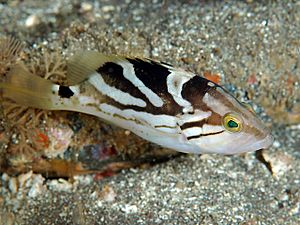Comet grouper facts for kids
Quick facts for kids Comet grouper |
|
|---|---|
 |
|
| Conservation status | |
| Scientific classification | |
| Synonyms | |
|
The comet grouper (Epinephelus morrhua) is a type of marine fish. People also call it the comet cod or dot-dash grouper. It belongs to the grouper family, which also includes sea basses. This fish lives in deep coral reefs in the Indo-Pacific ocean.
Contents
What Does the Comet Grouper Look Like?
The comet grouper has a body that is about 2.8 to 3.1 times longer than it is deep. Its head is slightly curved on top. The edges of its gill cover have small, sharp points.
Its dorsal fin (on its back) has 11 strong spines and 14-15 soft rays. The anal fin (on its belly) has 3 spines and 7-8 soft rays. The caudal fin (tail fin) can be slightly rounded or curved.
The fish's body and head are tan. They have dark brown stripes and spots. One stripe starts behind the eye and splits. One part goes to a dark spot near the dorsal fin. The other part goes along its side and splits again near the pectoral fin (side fin). Another dark stripe runs from the gill cover to the dorsal fin. There are also smaller stripes and spots, making it look like a "dot-dash" pattern.
Comet groupers can grow up to 90 centimetres (35 in) long. However, they are usually around 60 centimetres (24 in). The heaviest recorded one weighed about 6.7 kilograms (15 lb).
Where Do Comet Groupers Live?
The comet grouper lives in a large area called the Indo-Pacific. This includes the Red Sea and the coast of Africa, all the way to South Africa. They are also found across the Indian Ocean, including places like Madagascar and Mauritius.
In the Western Pacific Ocean, they live as far north as southern Japan. They are also found south in New South Wales, Australia. Their range extends to islands like New Caledonia, Fiji, and the Cook Islands.
Habitat and Lifestyle
Comet groupers live near coral reefs. They prefer slopes off islands, underwater mountains, or the edge of the continental shelf. You can find them at depths from 80 to 370 m (260 to 1,210 ft).
These fish eat other fish that live on the seafloor. They also eat large invertebrates, which are animals without backbones. Scientists don't know much about their daily lives. However, they do know that these fish can carry tiny parasites.
Naming the Comet Grouper
The comet grouper was first officially described in 1828. A French zoologist named Achille Valenciennes gave it the name Serranus morhua. He found the first one near Mauritius.
Sometimes, people confuse the comet grouper with its close relatives. These include E. poecilonotus, E. radiatus, and E. tuamotoensis.
How People Use Comet Groupers
The comet grouper is not often seen in fish markets. This is probably because they live in very deep waters, making them hard to catch. Even so, many people think they are a very tasty fish to eat.
See also
 In Spanish: Epinephelus morrhua para niños
In Spanish: Epinephelus morrhua para niños


